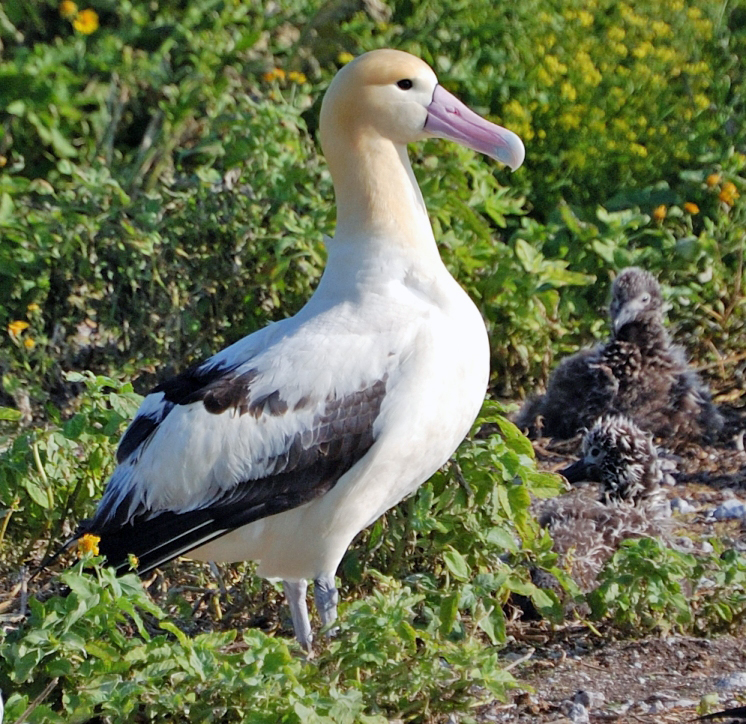Facts for Kids
Albatrosses are large seabirds known for their impressive wingspans and remarkable oceanic flight capabilities.
Overview
Unique Adaptations
Conservation Status
Cultural Significance
Threats And Challenges
Diet And Feeding Habits
Habitat And Distribution
Physical Characteristics
Reproduction And Nesting
Behavior And Social Structure
Scientific Research And Studies

Inside this Article
Samuel Taylor Coleridge
Southern Hemisphere
Laysan Albatross
Social Structure
Climate Change
Technology
Pollution
Energy
Ocean
White
Food
Did you know?
🐦 Albatrosses belong to the family Diomedeidae and are large seabirds.
🦅 They have impressive wingspans that can reach up to 12 feet.
🌊 Albatrosses can glide over the ocean for hours without flapping their wings.
🗺️ They are mostly found in the Southern Ocean around Antarctica and also in the North Pacific Ocean.
🐟 Albatrosses mainly eat fish, squid, and other marine creatures.
💕 These birds mate for life and are devoted parents.
🚼 Albatrosses usually lay only one egg every two years.
🏝️ They gather in large groups called colonies and enjoy performing courtship dances.
🌍 Many albatross species are vulnerable or endangered due to human activities.
✊ Organizations are working hard to protect albatrosses and their habitats.
Introduction
They are known for their impressive wingspan, which can reach up to 12 feet! These birds spend most of their lives soaring over the ocean. They can glide for hours without flapping their wings. Albatrosses are found in the Southern Ocean around Antarctica and the North Pacific Ocean. 🌊
There are some well-known species, like the Wandering Albatross and the Laysan Albatross. These birds are incredible travelers, flying thousands of miles in search of food!
Unique Adaptations
One of their most impressive features is their ability to glide for long distances without flapping. They use a technique called dynamic soaring, which allows them to catch the wind's energy. Albatrosses also have a special gland that helps them drink saltwater, filtering out the salt! 🧂
Their strong wings and streamlined bodies make them excellent flyers, traveling thousands of miles every year in search of food!
Conservation Status
Some are listed as vulnerable or endangered because their populations are declining. The biggest threats they face come from human activities, such as fishing nets and pollution. When trapped, they can struggle to survive. Organizations are working hard to protect these amazing birds, creating safe habitats and reducing fishing hazards! Together, we can help make sure albatrosses continue to soar in our oceans for generations to come! ✊
Cultural Significance
In literature, the famous poem "The Rime of the Ancient Mariner" by Samuel Taylor Coleridge tells the tale of a sailor who shoots an albatross, leading to misfortune. This poem teaches us to respect nature! Albatrosses are also seen as symbols of good luck among sailors. ⚓
Many coastal communities celebrate these majestic seabirds to raise awareness about their protection and the importance of a healthy ocean!
Threats And Challenges
Sometimes they get caught in fishing nets or fishing lines, which can be very dangerous. Pollution, like plastic waste and oil spills, also harms their ocean habitat. 🌍
Climate change is another challenge, as it affects fish populations and ocean temperatures. Conservation efforts are essential to protect albatrosses and ensure they have a safe ocean to live in!
Diet And Feeding Habits
They mainly eat fish, squid, and other marine creatures. They are known to dive for food but prefer to grab it from the ocean's surface. Albatrosses have a special trick: they can smell food from miles away! With their keen eyesight, they spot schools of fish and swoop down to catch them. 🌊
Sometimes, they follow fishing boats to gobble up any leftovers, making them clever feeders who know how to find a meal!
Habitat And Distribution
️ They prefer open ocean environments where they can easily catch food. Some species can travel great distances, sometimes flying thousands of miles for a single meal! 🥳
They are also seen in the North Pacific Ocean, visiting places like the Aleutian Islands. While they can land on islands, they prefer the freedom of the vast sea!
Physical Characteristics
Their wings are long and can be up to 3.6 meters (12 feet) wide. They have strong, sturdy bodies covered in feathers that are usually white or gray. A unique feature is their hooked bills, which help them catch slippery fish and squid. These birds can weigh between 6.5 to 12 kg (14 to 26 pounds). The Wandering Albatross is the largest, with a wingspan that can be longer than a smart car! 🚗
Their beautiful feathers also keep them warm in chilly ocean waters.
Reproduction And Nesting
They mate for life, forming strong bonds with their partners. These birds take time to build their nests, which are often located on rocky islands. A nest is made from grass and dirt, creating a cozy spot for their eggs. Albatrosses usually lay one egg every two years! The parents take turns keeping the egg warm until it hatches. 🚼
Once the chick is born, both parents feed it by regurgitating soft food. After several months, the chick learns to fly and eventually leaves the nest!
Behavior And Social Structure
They can be seen flying together, chatting, and performing beautiful courtship dances! Dancing helps them bond with their mates. These birds are also known for their adventurous spirit; they can fly for weeks without landing! 🏝
️ Albatrosses communicate with a variety of sounds, from honks to soft coos. Their clever social structure helps them find mates and care for their young.
Scientific Research And Studies
Research includes tracking their movements with GPS technology to see where they fly and what they eat. By understanding their habitat needs, scientists can help create better protections for these birds. 🌐
Studies show how climate change impacts their food sources and breeding patterns. Through research, we can discover ways to keep albatross populations healthy and support their journey across the vast seas! 🦅

